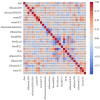Development and validation of a predictive model for tuberculous pleural effusion with high adenosine deaminase
- PMID: 40885841
- PMCID: PMC12398481
- DOI: 10.1038/s41598-025-17864-8
Development and validation of a predictive model for tuberculous pleural effusion with high adenosine deaminase
Abstract
Tuberculous pleural effusion (TPE) can be effectively diagnosed using adenosine deaminase (ADA); however, high ADA levels in pleural effusion (PE) have also been shown to be linked to other diseases. In this study, we aimed to develop and validate a prediction model and differentiate TPE in patients with high ADA levels. This retrospective analysis of patients with ADA levels ≥ 25 IU/L was conducted at our healthcare institution between January 2017 and December 2023. After collecting and analyzing clinical and laboratory data, we developed predictive models using 31 indicators from serum and PE. The model's performance was assessed using the area under the receiver operating characteristics curve (AUC), accuracy, sensitivity, and specificity. Based on their significance in disease prediction, the top five variables were selected for use in constructing the prediction model. We externally validated the diagnostic model using a cohort from a different hospital. Among the 237 included patients with high ADA levels, 133 (56.1%) and 104 (43.9%) were diagnosed with TPE and non-TPE, respectively. The LightGBM model was superior to the other models, achieving an AUC of 0.926, with high accuracy, sensitivity, and specificity. The top five variables, including effusion lymphocyte percentage, effusion lactate dehydrogenase/ADA, age, effusion total protein, and peripheral blood platelet count, were essential for creating an accurate predictive model, which demonstrated strong performances on the training, test, internal validation, and external validation sets. The results were then validated with decision curve analysis and a calibration curve. This novel predictive model based on clinical and laboratory features in serum and PE showed strong diagnostic capability in detecting TPE in patients with high ADA levels.
Keywords: Adenosine deaminase; Prediction model; Tuberculous pleural effusion.
© 2025. The Author(s).
Conflict of interest statement
Declarations. Competing interests: The authors declare no competing interests.
Figures








References
-
- Light, R. W. Pleural effusions. Med. Clin. N. Am.95(6), 1055–1070. 10.1016/j.mcna.2011.08.005 (2011). - PubMed
-
- Gopi, A., Madhavan, S. M., Sharma, S. K. & Sahn, S. A. Diagnosis and treatment of tuberculous pleural effusion in 2006. Chest131(3), 880–889. 10.1378/chest.06-2063 (2007). - PubMed
-
- Kirsch, C. M. et al. The optimal number of pleural biopsy specimens for a diagnosis of tuberculous pleurisy. Chest112(3), 702–706. 10.1378/chest.112.3.702 (1997). - PubMed
-
- Palma, R. M., Bielsa, S., Esquerda, A., Martínez-Alonso, M. & Porcel, J. M. Diagnostic accuracy of pleural fluid adenosine deaminase for diagnosing tuberculosis. Meta-analysis of Spanish studies. Arch. Bronconeumol. (Engl. Ed.)55(1), 23–30. 10.1016/j.arbres.2018.05.007 (2019). - PubMed
Publication types
MeSH terms
Substances
LinkOut - more resources
Full Text Sources
Research Materials

